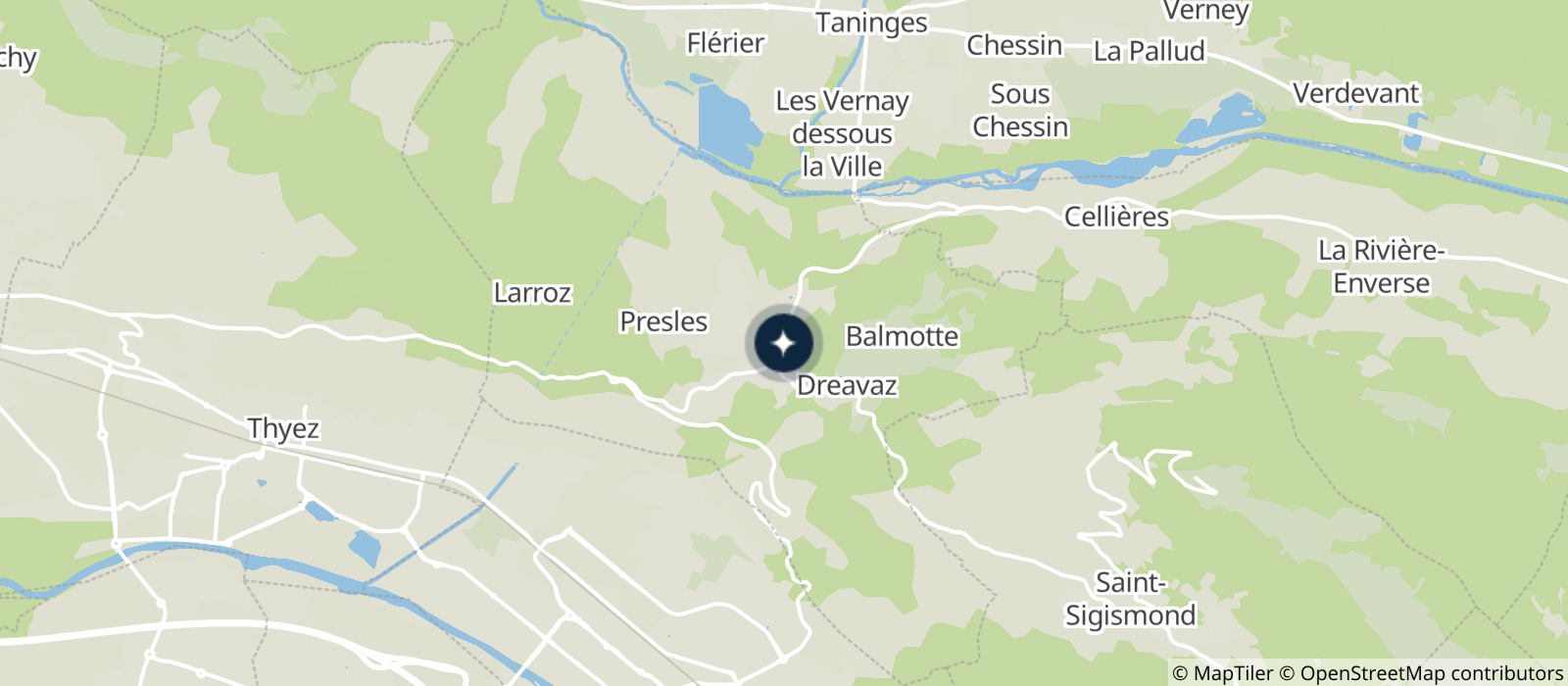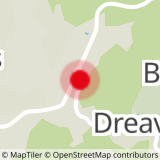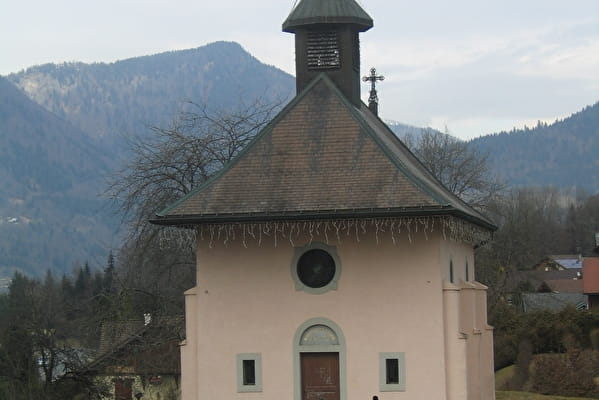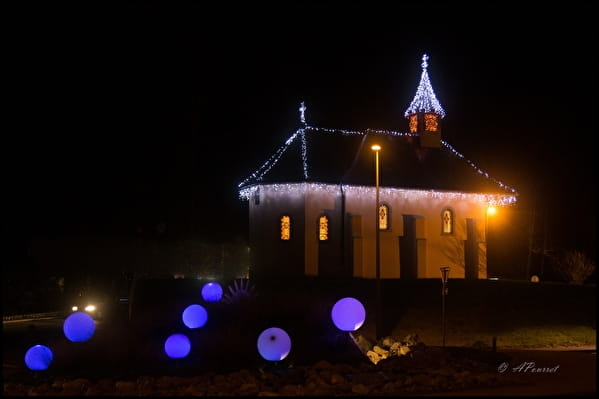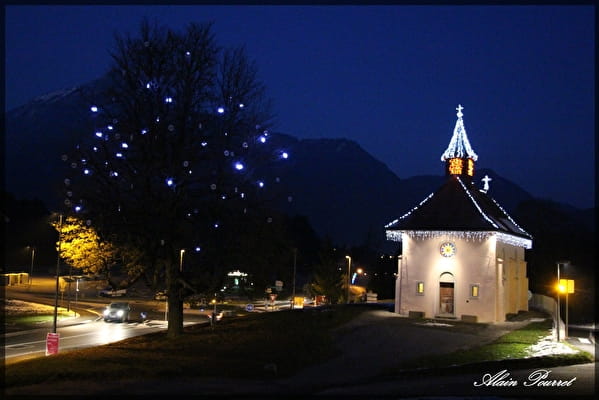The rectangular building has a flat apse. It is supported by six buttresses and protected by an overhanging roof topped with a small bell tower. The inside features a nave and a barrel-vault chancel on which daylight falls via four arched bay windows. The porch features a semi-circular pediment with an oculus at the top and two narrow rectangular windows on either side of the door. Thus, the shape of the building is fairly typical of pre-19th-century village chapels.
The vault is painted in scenes from the life of the Virgin Mary. The wrought iron communion table and the chancel's two stained glass windows date from 1937.
The chapel's most interesting features are the altar and its decoration.
The altar is straightforward but its painting and framework, originally from Monseigneur Biord's private chapel, are of excellent quality.
At first glance, the framework appears very plain; its four sides with prominent double mouldings are decorated with nothing but a central torus from which hang three stylised fleur-de-lys on one side and a string of beads on the other. But much more work has gone into its embellishment. From each of the side frames rises a volute decorated in a lace-like double scrollwork feature with one scroll wound around a tulip, the other enveloping a leaf. They wind their way up to a margent, a hanging vine branch with large leaves sheltering a jet-black cherub. The cap features the head of an angel, full of life, whose enormous curved wings lean against two shallow flower pots. At each corner, two gilt flower buds add a touch of gaiety.
The framework's dark tones bring out the colour of the painting which depicts Mary's visitation to her cousin, Elisabeth, spouse of Zacharia the priest, and mother of Saint John the Baptist. Painted on a low skyline which makes the characters seem even more imposing, the scene takes place at the entrance to Elisabeth's house. On the left, beyond the wall and through the open door, we see the greenery of the surrounding woodland, a backdrop to the monumental flight of stone steps that leads to a perron with a fence of narrow bars. At the centre of the picture, Mary and Elizabeth are separated by the vertical line of the corner of the wall, but bathe in the same atmospheric light, united by their matching tones of white - pinkish white for Mary, edging on gold and ochre for Elisabeth - as well as light blue, red and antique gold. Elisabeth leans toward her cousin, stooping to embrace her. Mary stands on the perron, upright and serene in a proudly firm posture, the heavy pleated train of her long dress trailing down to the bottom of the steps. The women's facial expressions and hand gestures suggest words of kindness, respect and restraint from Elisabeth while Mary emanates peace, joy and awareness of her exceptional fate.
Two men stand at either side of the quarter-circle containing the four characters. On the left, an aristocratic-faced Joseph, in the prime of his adulthood, stands smiling in his blue tunic and beige coat. He is waving with his left arm and holds in his right hand a sphere-shaped gift wrapped in a cloth. On the right-hand side stands Zacharia, who appears to be returning Joseph's greeting with a smile. He is dressed like a man of letters, in an ample black robe, a brown coat with blue lapels, and a white shirt with an open collar showing from the neck of the robe. Enhanced by the light, he has an extremely gentle face and wears a white-speckled beard full of elegant curls.
The whole scene is lit up by a large bright yellow circle at the top of the picture, from which a cone of shining light looks over the four heroes along with a white dove and four frolicking angels. We can see only the faces of the pair of angels on the left who seem to be lapping up the event's every detail while, on the right, the third angel plunges, hands together, next to a fat, baby-faced little angel with fine wings, perched on a green cloud and parting a red-lined blue robe in order to dance.
The bottom right-hand corner is occupied entirely by one more angel, a supple adolescent with chubby features, huge transparent wings, muscular arms and beautifully-groomed blonde hair. On one knee, he appears to be getting up, spreading his gilt-edged wings as they emerge from a heavy coat of red and emerald green. In his honest-looking alb, he faces us with a mischievous expression, inviting us to join in with this picture of happiness.
This fascinating painting presents us with three mysteries. Firstly, how does one explain the presence of a hooded face on the white cloth wrapped around the gift held by Joseph? Secondly, what are the pinkish patches on the large sheet mysteriously placed in front of Mary and to which she points imperiously? Thirdly, what is the meaning of the strange blue areas between this sheet and Mary's legs?
This picture certainly does have a few weak points: the heavy arm of the angel in the foreground, Zacharia's fingers which are too widely spaced, and the disproportion between the upper and lower parts of Elisabeth's body. But these flaws are drowned in the picture's overall quality: a clever layout with varying lighting, realistic locations, natural-looking figures defined by soft curves that make them stand out against the straight lines of the decor, the lively dialogue suggested by the faces and hands, the sharp finesse of the sketching, the freshness and radiance of the colours, the subtlety of the reflections and shadows on the characters' flesh or clothing (Zacharia's coat, for example, or the wings of the angel in the foreground), the almost imperceptible variations of hue in the seemingly plain white surfaces, and the brio with which the acrobatic angel, hands together, moves the lower part of his body.
Regardless of when it was painted (probably in the mid-18th century), the picture's classical architectural decor and its manneristic heritage revealed by some of the acidic blues and the small head sizes (Joseph and Elisabeth), combined with an almost romantic touch in the tender facial expressions, all contribute to the lightness, grace and power of expression that are so charmingly typical of Baroque art.
The chapel also houses a statue of the "Virgin and Child" in polychrome wood. The ivory-skinned Madonna wears a red gilt-edged robe and dark blue coat, as well as two ultimate attributes of royalty: a tall, richly decorated golden crown with a very fine hairnet, and a sceptre held in her right hand. The child Jesus, dressed in light blue, sits cradled by his mother's left arm, holding a golden globe with a cross on top. These two, untroubled figures appear extremely nonchalant, yet their faces, objects of popular art, are expressive.
To the right of the chapel entrance stands a whole gathering of wax figurines of children, votive offerings that have followed the recovery of sick or injured children after the intercession of Notre-Dame du Mont-Provent, worshipped for her power to bring unchristened children back from the dead, just long enough for them to receive the holy sacrament that opens the door to eternal salvation.
Extract from the book by Fernand Roulier and Denis Vidalie
Un Art Retrouvé, Le Faucigny.
Baroque churches and chapels, gems of Haute-Savoie
Editions Rossat Mignod.
- Historic site and monument
Mont Provent Chapel
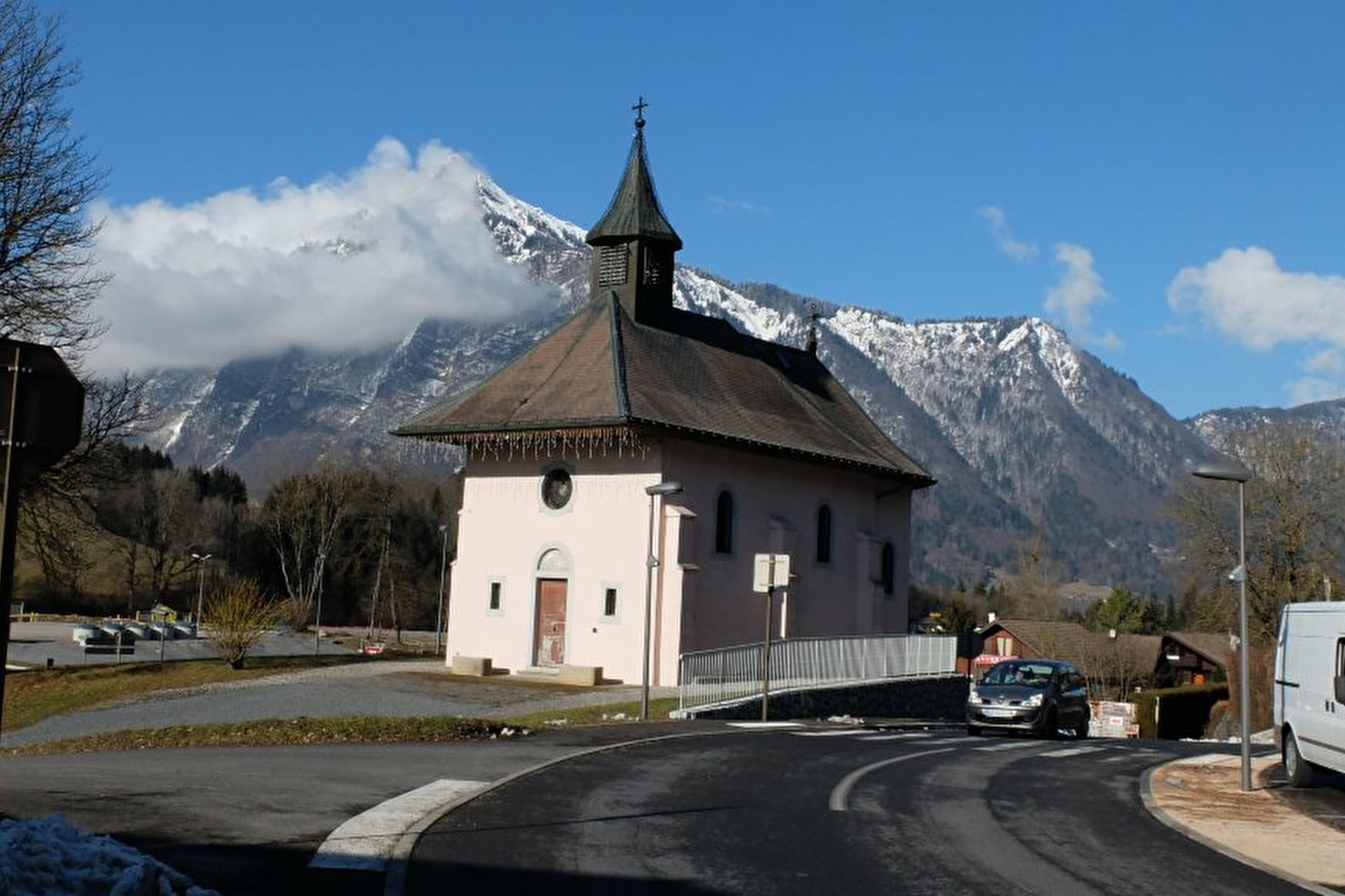
Today's chapel was built in 1838 a short distance away from the ruins of an older one. The chancel was added in 1937.
About
Prices
Free of charge.
Reception
Opening
All year round, daily.
Contacts
Access
